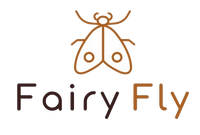Why biological pest control is better than chemicals
Author: FairyFly | Reading time: 7 minutes
When pests attack your plants, many people instinctively reach for the insect spray from the hardware store. Understandable—after all, the advertisements promise quick relief. But is chemical pest control really the best solution? In this article, you'll learn why biological pest control is not only more environmentally friendly, but also more effective and sustainable.
The crucial difference: combat vs. control
Chemical agents follow the principle of destruction : they kill everything—pests and beneficial organisms alike. This may seem effective at first, but it leads to a destroyed ecosystem.
Biologically beneficial organisms work according to the principle of control : They keep pest populations at a naturally low level without disrupting the biological balance. The result is more sustainable and stable.
Health: Your family comes first
The hidden dangers of chemical pesticides
Particularly problematic indoors:
- Respiratory tract exposure due to spray mist and evaporation
- Skin irritation upon direct contact
- Residues on surfaces where children play
- Stress on pets due to lower body weight
Long-term effects not yet fully researched: Many pesticides are suspected of having hormonal effects or affecting the nervous system. The risk increases particularly with regular use in enclosed spaces.
Biologically beneficial organisms: 100% safe
Completely harmless to humans:
- No toxic substances - beneficial insects are living organisms
- No respiratory hazard - no spray or fumes
- No skin contact necessary - application without direct contact
- Safe for pregnant women and small children
Scientifically confirmed: All beneficial organisms approved in Germany have undergone extensive safety testing. There are no known cases of health damage caused by biological pest control.
Environment: Responsibility for future generations
The ecological damage caused by chemicals
Bee protection: Many insecticides are highly toxic to bees and other pollinators. Even when used indoors, residues enter the environment via wastewater or landfills.
Water pollution: Household pesticides pollute wastewater treatment plants and waterways. Even at low concentrations, they can harm aquatic ecosystems.
Development of resistance: Through frequent use, pests develop resistance - a vicious circle of increasingly strong poisons is created.
Biological control: In harmony with nature
Promoting biodiversity: Beneficial organisms support the natural balance and promote biodiversity even in urban areas.
No environmental impact: Beneficial organisms leave no residues and do not pollute water or soil.
Sustainable cycle: Established populations of beneficial organisms work independently and reduce pest pressure in the long term.
Effectiveness: Facts and figures speak for themselves
Long-term success vs. short-term effect
Study by the University of Hohenheim (2019): Biological pest control showed a 95% success rate in the sustainable reduction of aphids after 3 months, while chemical agents only showed 78% long-term success .
Greenhouse comparison in the Netherlands: Farms using exclusively biological control had 40% fewer pest problems per year than farms using chemical control.
Resistance: The chemical dilemma
Development of resistance to chemical agents:
- Aphids: Up to 70% resistance to common insecticides
- Spider mites: Over 80% show resistance in intensively treated areas
- Thrips: Resistance to 5-8 different drug groups documented
Beneficial organisms: No resistance possible. Because beneficial organisms are living organisms that also adapt, pests cannot develop resistance. There is no arms race.
Costs: Consider the hidden expenses
Chemical control: seemingly cheap
Hidden follow-up costs:
- Frequent retreatment due to resistance
- Health costs due to stress
- Environmental damage - economic costs
- Damage to beneficial organisms - more pest problems
Biological control: real economic efficiency
Long-term view:
- Fewer treatments required due to sustainable success
- No resistance - consistent effectiveness
- Preventive effect - fewer new infestations
- Healthier plants - less replacement needed
Example calculation for houseplants:
- Chemical: 3-4 treatments at 15€ each = 45-60€ per year
- Biological: 1-2 treatments at 25€ each = 25-50€ per year
User-friendliness: Easier than you think
Myth: "Biology is complicated"
Modern beneficial organisms are user-friendly:
- Ichneumon wasp cards: Simply lay them out, done
- Predatory mites: spread and wait
- Nematodes: Stir into water and pour
No protective equipment required: While gloves, respiratory protection and protective clothing are often recommended for chemicals, beneficial insects can be applied completely safely.
Time savings through fewer treatments
Chemical agents:
- Weekly check-up and follow-up treatment
- Multiple application in case of resistance
- Cleaning contaminated surfaces
Biologically beneficial organisms:
- Apply once, effective for weeks
- Independent reproduction with sufficient prey
- No cleaning required
Special case: Edible plants and herbs
Chemicals: Waiting times and residues
Problematic for crops:
- Waiting periods of several weeks
- Residue controls necessary
- Taste changes possible
- Uncertainty when consuming
Organic: Ready to harvest immediately
No restrictions:
- No waiting times - ready to harvest immediately
- No residues on leaves or fruits
- Tasteless - no influence on aroma
- Organic quality is maintained
Science confirms: Biological is superior
Current research results
Journal of Economic Entomology (2020): "Biological control shows higher long-term efficiency and better cost-benefit ratios than chemical alternatives."
Study by the Julius Kühn Institute (2021): In 89% of the cases examined, biological control was more effective than chemical methods.
EU Commission report (2019): "Integrated pest management with a focus on biological methods reduces pesticide use by an average of 65% without yield losses."
Professional users rely on organic
Greenhouse farms in Europe:
- 95% of tomato producers in the Netherlands work organically
- German ornamental plant companies reduce chemicals by 80%
- Success rate over 90% when used correctly
Future trends: Biological is the future
Legal developments
EU "Farm to Fork" strategy: The use of chemical pesticides is to be reduced by 50% by 2030. Organic alternatives are being massively promoted.
National action plans: Germany plans to tighten regulations on chemical pesticides and promote biological methods.
Social change
Consumer awareness:
- 78% of Germans prefer pesticide-free food
- Growing demand for environmentally friendly solutions
- Health awareness is continuously increasing
Urbanization: In cities, biological methods are preferred because the use of chemicals is often restricted or prohibited.
Conclusion: The decision is obvious
Biological pest control is not only an environmentally friendly alternative - it is superior to chemical control in many aspects:
For your health: No toxins in your home For the environment: Protection of bees, waters and biodiversity
For your wallet: Long-term savings through sustainable effects For effectiveness: No resistance, lasting protection For the future: On the safe side of social development
The first step is simple
You don't have to change your entire system at once. Start with biological beneficials the next time you encounter a pest infestation—you'll be surprised at how effective and uncomplicated this natural solution is.
Do you have questions about switching to biological pest control? We're happy to advise you on selecting the right beneficial organisms for your specific needs. For a healthier future – for you and our planet.



